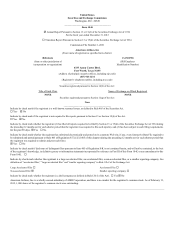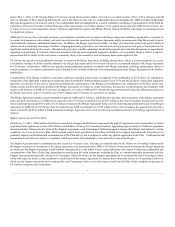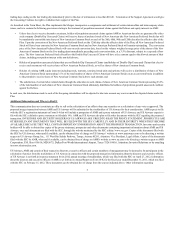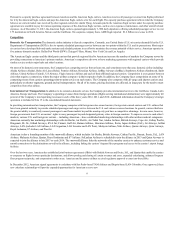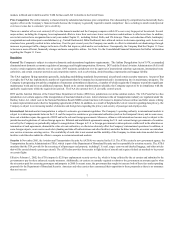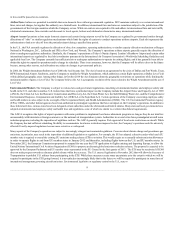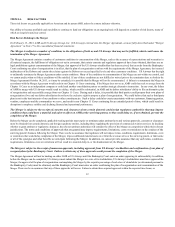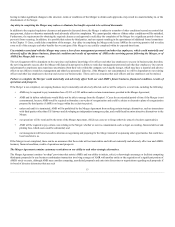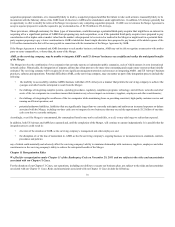American Airlines 2012 Annual Report Download - page 7
Download and view the complete annual report
Please find page 7 of the 2012 American Airlines annual report below. You can navigate through the pages in the report by either clicking on the pages listed below, or by using the keyword search tool below to find specific information within the annual report.
markets in Brazil and Colombia and for TAM Airlines and LAN Colombia in the United States.
Price Competition The airline industry is characterized by substantial and intense price competition. Fare discounting by competitors has historically had a
negative effect on the Company’s financial results because the Company is generally required to match competitors’ fares, as failing to match would provide
even less revenue due to customers’ price sensitivity.
There are a number of low-cost carriers (LCCs) in the domestic market and the Company competes with LCCs over a very large part of its network. Several
major airlines, including the Company, have implemented efforts to lower their costs since lower cost structures enable airlines to offer lower fares. In addition,
several air carriers have reorganized in recent years under Chapter 11, including United, Delta, and US Airways. These cost reduction efforts, bankruptcy
reorganizations and subsequent consolidations (e.g., United/Continental; Delta/Northwest) have allowed carriers to decrease operating costs. Lower cost
structures have generally resulted in fare reductions. Over the past several years, the Company was unable to offset its substantial cost disadvantage through
increases in passenger traffic, changes in the mix of traffic that improve yields and/or cost reductions. Consequently, the Company filed the Chapter 11 Cases
to become a more efficient, financially stronger and more competitive airline. See Note 1 to the Consolidated Financial Statements for further information
regarding the Chapter 11 Cases.
Regulation
General The Company is subject to extensive domestic and international regulatory requirements. The Airline Deregulation Act of 1978, as amended,
eliminated most domestic economic regulation of passenger and freight transportation. However, DOT and the Federal Aviation Administration (FAA) still
exercise certain regulatory authority over air carriers. DOT maintains jurisdiction over the approval of international codeshare agreements, international route
authorities, and certain consumer protection and competition matters, such as advertising, denied boarding compensation and baggage liability.
The FAA regulates flying operations generally, including establishing standards for personnel, aircraft and certain security measures. As part of that
oversight, the FAA has implemented a number of requirements that the Company has incorporated and is incorporating into its maintenance programs. The
Company is progressing toward the completion of numerous airworthiness directives, a number of which require the Company to perform significant
maintenance work and to incur additional expenses. Based on its current implementation schedule, the Company expects to be in compliance with the
applicable requirements within the required time periods. The FAA also operates the U.S. air traffic control system.
DOT and the Antitrust Division of the United States Department of Justice (DOJ) have jurisdiction over airline antitrust matters. The U.S. Postal Service has
jurisdiction over certain aspects of the transportation of mail and related services. Labor relations in the air transportation industry are regulated under the
Railway Labor Act, which vests in the National Mediation Board (NMB) certain functions with respect to disputes between airlines and labor unions relating
to union representation and collective bargaining agreements (CBAs). In addition, as a result of heightened levels of concern regarding data privacy, the
Company is subject to an increasing number of domestic and foreign laws regarding the privacy and security of passenger and employee data.
International International air transportation is subject to extensive government regulation. The Company’s operating authority in international markets is
subject to aviation agreements between the U.S. and the respective countries or governmental authorities (such as the European Union), and in some cases,
fares and schedules require the approval of DOT and/or the relevant foreign governments. Moreover, alliances with international carriers may be subject to the
jurisdiction and regulations of various foreign agencies. Bilateral and multilateral agreements among the U.S. and various foreign governments of countries
served by the Company are periodically subject to renegotiation. Changes in U.S. or foreign government aviation policies could result in the alteration or
termination of such agreements, diminish the value of route authorities, or otherwise adversely affect the Company’s international operations. In addition, at
some foreign airports, an air carrier needs slots (landing and take-off authorizations and other facilities) and other facilities before the air carrier can introduce
new service or increase existing service. The availability of such slots is not assured and the inability of the Company to obtain and retain needed slots and
facilities could therefore inhibit its efforts to compete in certain international markets.
Security In November 2001, the Aviation and Transportation Security Act (ATSA) was enacted in the U.S. The ATSA created a new government agency, the
Transportation Security Administration (TSA), which is part of the Department of Homeland Security and is responsible for aviation security. The ATSA
mandates that the TSA provide for the screening of all passengers and property, including U.S. mail, cargo, carry-on and checked baggage, and other articles
that will be carried aboard a passenger aircraft. The ATSA also provides for security in flight decks of aircraft and requires federal air marshals to be present
on certain flights.
Effective February 1, 2002, the ATSA imposed a $2.50 per enplanement security service fee, which is being collected by the air carriers and submitted to the
government to pay for these enhanced security measures. Additionally, air carriers are annually required to submit to the government an amount equal to what
the air carriers paid for screening passengers and property in 2000. In recent years, the government has sought to increase both of these fees under spending
proposals for the Department of Homeland Security. American and other carriers have announced their opposition to these proposals as there is no assurance
that any increase
7

